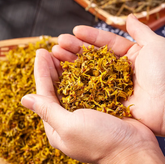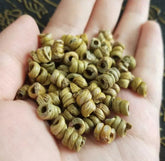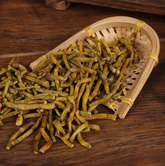Ginseng - One of the Nine Noble Herbs
Botanically, Ginseng belongs to the genus Panax in the family Araliaceae.
It is a perennial herb with a short rhizome (the part called "Lu Tou" in Chinese). The main root is fleshy, cylindrical or fusiform in shape, usually pale yellowish-white, sometimes with a light brown outer skin, and has a few distinct fine root branches. The stem is erect, single, and unbranched, usually about 30 - 60 centimeters tall. Its leaves are palmately compound leaves, typically with 3 - 6 leaflets. The leaflets are oval to oblong-oval in shape, with fine serrations on the edges. There are a few bristles scattered on the veins on the upper surface, and the lower surface is hairless. The umbel is solitary and terminal, and the flowers are small and pale yellowish-green. The fruit is a flattened spherical drupe, which is bright red when ripe.
Ginseng prefers to grow under deciduous broad-leaved forests or mixed coniferous and broad-leaved forests at an altitude of several hundred meters. The soil there should be fertile, loose, and well-drained. Meanwhile, it requires certain shading conditions. It is quite sensitive to environmental factors such as light, temperature, and moisture, making it a rather delicate plant. For example, ginseng needs sufficient scattered light for photosynthesis but cannot tolerate direct strong sunlight, so the shaded environment of the forest is crucial for it.
Ginseng grows extremely slowly. It usually takes several years from sowing to harvest. Generally, ginseng that has grown for 5 - 6 years is of relatively good quality. Moreover, the older the ginseng is, the higher its value is traditionally considered, which is one of the reasons why it is precious.
In Asia, especially in countries like China and the Republic of Korea, Ginseng has an extremely high status in traditional medicine. It has a history of medicinal use for thousands of years and is regarded as a precious medicinal herb for nourishing and strengthening the body, and is known as the "King of Herbs". There are numerous records about its medicinal effects and usage methods in ancient medical books. It is often used to regulate physical weakness and restore vitality.
Ginseng also symbolizes good wishes such as health, longevity, and vitality at the cultural level. It appears in many traditional stories, paintings, and folk activities, reflecting people's longing and pursuit for a healthy and beautiful life.
In traditional Chinese medicine, Ginseng tastes sweet, slightly bitter, and has a slightly warm nature. It acts on the spleen, lung, heart, and kidney meridians. It has the functions of greatly tonifying qi, restoring pulse and arresting collapse, invigorating the spleen and benefiting the lung, promoting fluid production and nourishing blood, and calming the mind and enhancing intelligence.
Modern scientific research has shown that Ginseng contains various active ingredients, such as ginsenosides, polysaccharides, volatile oils, and amino acids. Ginsenosides are one of its main active components and have pharmacological effects in regulating the body's immune function, improving cardiovascular function, relieving fatigue, resisting oxidation, and anti-tumor, etc. It has great potential for development in the fields of medicine and health care.
Ginseng can be made into various forms for consumption. Commonly, it can be sliced and directly soaked in water for drinking, allowing people to gradually absorb its nutrients. It can also be used to make soup. For example, it can be stewed with ingredients like wolfberries and chicken, so that the nutrients are integrated into the soup, which tastes delicious and has obvious nourishing effects. Besides, it can be made into ginseng wine. After soaking ginseng in white liquor for a period of time, the liquor will have the unique flavor and medicinal value of ginseng. Moderate consumption is beneficial to health.
Wild ginseng resources have become extremely scarce due to excessive excavation. Many countries have listed wild ginseng as a protected species. For example, China has listed wild ginseng as a national first-class key protected wild plant. Through measures such as establishing protected areas and standardizing the standards for artificial cultivation, while reasonably utilizing the value of ginseng, efforts are being made to protect wild ginseng resources to ensure its sustainable development.
- Choosing a selection results in a full page refresh.







